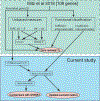Evidence for common mechanisms of pathology between SHANK3 and other genes of Phelan-McDermid syndrome
- PMID: 38414139
- PMCID: PMC11025605
- DOI: 10.1111/cge.14503
Evidence for common mechanisms of pathology between SHANK3 and other genes of Phelan-McDermid syndrome
Abstract
Chromosome 22q13.3 deletion (Phelan-McDermid) syndrome (PMS, OMIM 606232) is a rare genetic condition that impacts neurodevelopment. PMS most commonly results from heterozygous contiguous gene deletions that include the SHANK3 gene or likely pathogenic variants of SHANK3 (PMS-SHANK3 related). Rarely, chromosomal rearrangements that spare SHANK3 share the same general phenotype (PMS-SHANK3 unrelated). Very recent human and model system studies of genes that likely contribute to the PMS phenotype point to overlap in gene functions associated with neurodevelopment, synaptic formation, stress/inflammation and regulation of gene expression. In this review of recent findings, we describe the functional overlaps between SHANK3 and six partner genes of 22q13.3 (PLXNB2, BRD1, CELSR1, PHF21B, SULT4A1, and TCF20), which suggest a model that explains the commonality between PMS-SHANK3 related and PMS-SHANK3 unrelated classes of PMS. These genes are likely not the only contributors to neurodevelopmental impairments in the region, but they are the best documented to date. The review provides evidence for the overlapping and likely synergistic contributions of these genes to the PMS phenotype.
Keywords: Phelan‐McDermid syndrome; gene expression; inflammation; neurodevelopment; synaptic function.
© 2024 The Authors. Clinical Genetics published by John Wiley & Sons Ltd. This article has been contributed to by U.S. Government employees and their work is in the public domain in the USA.
Conflict of interest statement
Competing Interests
Authors declare no competing interests.
Figures



Similar articles
-
Dissecting the 22q13 region to explore the genetic and phenotypic diversity of patients with Phelan-McDermid syndrome.Eur J Med Genet. 2023 May;66(5):104732. doi: 10.1016/j.ejmg.2023.104732. Epub 2023 Feb 21. Eur J Med Genet. 2023. PMID: 36822569 Review.
-
Phelan-McDermid syndrome: a classification system after 30 years of experience.Orphanet J Rare Dis. 2022 Jan 29;17(1):27. doi: 10.1186/s13023-022-02180-5. Orphanet J Rare Dis. 2022. PMID: 35093143 Free PMC article.
-
Definition and clinical variability of SHANK3-related Phelan-McDermid syndrome.Eur J Med Genet. 2023 Jul;66(7):104754. doi: 10.1016/j.ejmg.2023.104754. Epub 2023 Mar 31. Eur J Med Genet. 2023. PMID: 37003575
-
Delineation of the genetic and clinical spectrum of Phelan-McDermid syndrome caused by SHANK3 point mutations.Mol Autism. 2018 Apr 27;9:31. doi: 10.1186/s13229-018-0205-9. eCollection 2018. Mol Autism. 2018. PMID: 29719671 Free PMC article.
-
Fraternal twins with Phelan-McDermid syndrome not involving the SHANK3 gene: case report and literature review.BMC Med Genomics. 2020 Oct 6;13(1):146. doi: 10.1186/s12920-020-00802-0. BMC Med Genomics. 2020. PMID: 33023580 Free PMC article. Review.
Cited by
-
Metataxonomic and Immunological Analysis of Feces from Children with or without Phelan-McDermid Syndrome.Microorganisms. 2024 Oct 2;12(10):2006. doi: 10.3390/microorganisms12102006. Microorganisms. 2024. PMID: 39458315 Free PMC article.
-
Genome Sequencing Uncovers Additional Findings in Phelan-McDermid Syndrome.Am J Med Genet B Neuropsychiatr Genet. 2025 Jun 16:e33036. doi: 10.1002/ajmg.b.33036. Online ahead of print. Am J Med Genet B Neuropsychiatr Genet. 2025. PMID: 40519070
-
Sulfotransferase 4A1 Coding Sequence and Protein Structure Are Highly Conserved in Vertebrates.Genes (Basel). 2024 Jul 13;15(7):914. doi: 10.3390/genes15070914. Genes (Basel). 2024. PMID: 39062693 Free PMC article. Review.
-
A Proposal for Neurocognitive Assessment in Spanish-Speaking Adults With Phelan-McDermid Syndrome: A Case Report.Cureus. 2025 Jun 1;17(6):e85197. doi: 10.7759/cureus.85197. eCollection 2025 Jun. Cureus. 2025. PMID: 40600073 Free PMC article.
-
Uncovering genetic contributors to developmental delay and intellectual disability: a focus on CNVs in pediatric patients.Front Genet. 2025 Jun 23;16:1539902. doi: 10.3389/fgene.2025.1539902. eCollection 2025. Front Genet. 2025. PMID: 40626178 Free PMC article.
References
-
- Vitrac A, Leblond CS, Rolland T et al.: Dissecting the 22q13 region to explore the genetic and phenotypic diversity of patients with Phelan-McDermid syndrome. European journal of medical genetics 2023; 66: 104732. - PubMed
Publication types
MeSH terms
Substances
Supplementary concepts
Grants and funding
LinkOut - more resources
Full Text Sources
Miscellaneous

